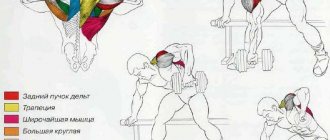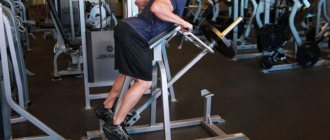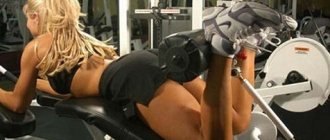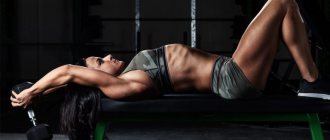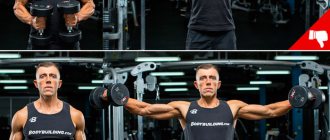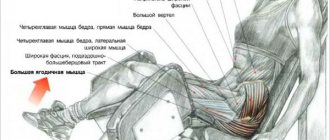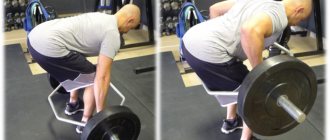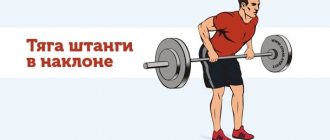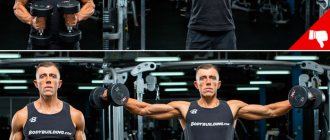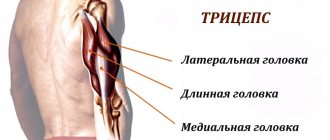The bent over arm extension exercise pumps up all three heads of the triceps, especially their lower parts. Gives symmetry and relief to the triceps. Isolation exercise.
In bodybuilding , bent over arm extension with a dumbbell is used to achieve symmetry in the development of the left and right triceps, honing their shape and relief.
Because the angle of the triceps load is completely different than other exercises, the back extension is a powerful tool for spurring triceps growth, especially when you're stuck in a plateau.
In addition, the additional static load that the triceps experiences when you hold your arm with the dumbbell fully straightened back engages the deepest muscle fibers of the triceps muscle, which is extremely important when working on detailing and separation of the triceps.
By regularly practicing back extensions, you will improve your athletic performance in sprinting (extending the arms in time with the movement of the legs to develop acceleration), martial arts (backhand punches), luge (pushing out at the start), tennis (hitting the ball backhand, if you are right-handed).
Bent-over dumbbell extensions - triceps exercise
Benefits and disadvantages of exercise
Dumbbell curls are ideal for pumping and high-repetition training. It is also recommended for static-dynamic training methods, but in this case it is necessary to work in a reduced amplitude and not perform full straightening at the elbow.
The main benefits of dumbbell triceps extensions:
- A universal movement that suits men and women.
- Loads all triceps heads.
- Does not create a harmful effect on the elbow joint.
- Can be performed in the gym or at home.
- Allows you to pump your triceps efficiently even when working with light weights.
- Great for pumping.
- An isolation movement that targets the target muscle.
The exercise has only one drawback - in terms of effectiveness, the movement is inferior to powerful strength exercises for the triceps (French presses and others). This is due to the fact that in this movement it is very difficult to work with large weights and this is a targeted exercise that specifically “hits” the triceps.
Safety
This exercise will be completely safe if you work with light weight. At the same time, there is no need to swing your torso once again. At this point, your spine will be in an unstable position, which can cause you to injure yourself or strain your back muscles.
When performing bent-over dumbbell arm extensions, it is important to monitor the position of your upper arm. It must be motionless , otherwise there is a risk of injuring the shoulder joints. In addition, any jerking movements should be avoided, as they place excessive strain on the joints and ligaments.
What muscles work
This is an isolating movement for the triceps, so when performed correctly, the entire load is reduced to the target muscle. Main muscles involved:
- Triceps brachii muscle (with emphasis on the upper part).
- Posterior deltoid bundle.
Also, when moving the arm back, the forearm, brachialis and iliac serratus muscles are activated.
Technique of one-arm extension while leaning on a bench
There are several techniques that differ from each other in some features. Performing in support on a bench is the most “isolating” option, which allows you to feel every centimeter of arm movement.
Technique:
- Go to the bench, rest your knee and palm on it (arm fully straightened). Bend your other arm at the elbow and hold the dumbbell with a neutral grip. The back is straight, the neck is in a natural position.
- Begin to straighten your arm, moving the dumbbell back and up away from you at a slow pace.
- Without pausing, return to the starting position.
It is important to monitor the following nuances that determine the quality of arm extension:
- The elbow should be pressed as close to the body as possible.
- The upper arm should be parallel to the spine.
- In the starting position, the elbow is bent at a right angle.
- You should not pause at the top; this will not improve efficiency, but will create additional stress on the elbow.
- The exercise is done at a slow pace, excluding inertia and “falling” of the hand in the negative phase.
Notes when performing bent over arm extensions
Notes
- The bent over arm extension is best used as an auxiliary exercise for working the triceps .
- When performing the exercise, do not bend your arm excessively at the elbow in the starting position. The optimal angle at the elbow joint is 90-95 degrees.
- At the top point of the amplitude, the arm should be fully straightened. of the exercise further increased by concentrated fixation of the hand at the top point for 1 second. As for the lower point of the amplitude of the exercise , there should be no pauses at this point.
- The dynamics of the exercise can be described as: straightening the arm with a powerful force of the triceps and smoothly lowering it after reaching the highest point of the amplitude. That is, in the negative phase of the exercise , when the arm is lowered from the dumbbells to its original state, the dynamics of the movement are smoother than when the arm is raised.
- The exercise can be performed without resorting to a support and with both hands at once. Bent-over arm extensions while standing are no less effective, but require greater concentration in the technique. This option is more suitable for experienced athletes.
Bent over arm extension technique with dumbbells
This version of the execution is often called the “skier”, since the movement of the hands is similar to working with sticks.
Technique:
- Stand straight, feet shoulder-width apart, hold dumbbells in your hands.
- Lean forward as low as possible (ideally, your body should be parallel to the floor) and keep your back straight. Bend your elbows.
- Begin to move both arms back, straightening your elbows.
- Without delay, return to the starting position.
- It is important to ensure that moving the arm back while tilting does not turn into rapid swings of the skier, since the load with this option will be distributed to other muscles. The movement should be done slowly and under control.
- Also try to exclude your shoulders and back from working.
- The degree of load is regulated by the position of the body (the greater the tilt, the stronger the load).
Exercise technique
Regardless of what type of dumbbell curl you perform (standing, sitting, bent over, etc.), the technical principles are always the same. Maintaining the correct technique will help you better concentrate on working your biceps and protect you from possible injuries.
- In the starting position, the arm is fully extended, the back is straight, and the elbows are located as close to the body as possible or are fixed (as with concentrated curls or biceps curls on a Scott bench). The exception is the bent-over dumbbell curl - here the elbow does not have any support and we cannot press it against the body. However, this does not mean that you can move your elbow forward or backward - this is fraught with injury.
- Lifting the dumbbell is done while exhaling. Many people misunderstand the name of the exercise. The bending of the arm should represent exactly the bending of the arm, and not the throwing of the dumbbell upward with the effort of the whole body. It is important for us to properly load the biceps, and not to throw the dumbbell into a vertical position at any cost.
- The negative phase of the movement should be accompanied by inhalation. The movement should be smooth, it is important to focus on the feeling of stretching in the biceps.
Bent over arm extension technique with dumbbells
This variation is an attempt to eliminate the work of the back and shoulder muscles, as well as inertia, when compared with the standing version. Seated arm extensions do not provide any tangible benefits, but may be more effective for those who are unable to focus the work on the triceps.
Technique:
- Sit on the edge of the bench and lean your body forward as much as possible. The back should remain straight. The elbows are bent at a right angle, the arms are pressed to the body.
- Start moving the dumbbells back until your elbow is completely straight.
- Without pausing, return to the starting position.
This movement can be performed with both hands together, alternately, or with one hand.
Bent-over one-arm dumbbell extension
FITNESS AND BODYBUILDING
Exercise, nutrition, training programs
BODYSPORTAL.COM
= 10 thousand readers
- home
- Blog
- Exercises
- Workouts at home
- Nutrition
- Programs
- Sportspit
- Trainer
- Adviсe
- Interesting
- Body-building
- Fitness

Training programs on BodySportal.com - fitness and bodybuilding, personal training ONLINE
- Back
- Breast
- Hands
- Shoulders
- Legs
- Buttocks
- Stomach
☝ ☎ Details on WhatsApp
Body-building
- Home WorkoutsFor Weight LossPersonal TrainerNutritional SupplementsArticlesExercisesNutrition
Exercises
- NeckLower BackBellyArmsShouldersChestBackButtocksLegs
sports nutrition
- ProteinAmino acidsCarbohydratesCreatineFat burnersPre-workoutsMultivitaminsVitamins
Starting position: standing. Keep your legs firmly apart, knees slightly bent, lean forward, keep your back straight. Place one hand on the knee, and bend the other (working) at the elbow at an angle of 90°, pressing it to the body:
- take a breath, straighten your arm back, straightening it at the elbow;
- At the end of the movement, exhale.
Extension of one arm back with a dumbbell in an inclined position - the beginning of the movement
This exercise is great for refining your triceps .
To achieve the best results, when performing this movement, achieve a burning sensation in the muscles.
Video for the exercise - one-arm back extension with a dumbbell in an inclined position
Application of the exercise: one-arm back extension with a dumbbell in an inclined position
To whom: Everyone, from beginner to master.
When: In the second half of the workout. The last or penultimate one to train the triceps. Before extending one arm back with a dumbbell in an incline position, perform triceps push-ups with your back to the bench and extension of the arms with one dumbbell from behind your head.
How much: 3-4 sets of 8-15 repetitions alternately on each arm.
Triceps exercises:
- Extension of arms with the handle of the upper block with an overhand grip
- Arm extension with the handle of the upper block with an underhand grip
- One-arm extension with an overhead pulley with an underhand grip
- Bench barbell extension (French press)
- Lying dumbbell extension
- Extension of one arm with a dumbbell from behind the head
- Extension of arms with one dumbbell from behind the head
- Extension of arms with a curved barbell from behind the head
- Bent-over one-arm dumbbell extension
- Triceps push-ups with back to bench
Hand exercises
Best articles
- Bodybuilding exercises for the back
- Arnold's technique
- Mass program
- Basics for weight loss
- Fitness exercises for the pectoral muscles
New on the site
- Bicep curls
- Biceps exercise
- Warm-up
- MuscleMeds
- Kolem coconut
- Pumping up the triceps
- Pumping up your biceps
- Nutrition program
- Workout
- Pumping up muscles
«>
- home
- Blog
- Exercises
- Workouts at home
- Nutrition
- Programs
- Sportspit
- Trainer
- Adviсe
- Interesting
- Body-building
- Fitness

Copyright © 2012 — 2020 E-mail: [email protected]
Recommendations
- This exercise should not be considered a primary triceps movement. The exception is when an athlete trains at home and only has a pair of dumbbells.
- Abductions are good for finishing off the triceps at the end of a workout, pumping, or high-rep failure sets.
- The one-handed option on a bench is considered the most effective, as it is characterized by maximum muscle control and minimization of inertia.
- Men are recommended to work in the 10 to 15 rep range, preferably reaching muscle failure at the end of the set.
- Girls can perform 12-17 repetitions, especially if the goal is to tighten and improve the relief of the triceps.

